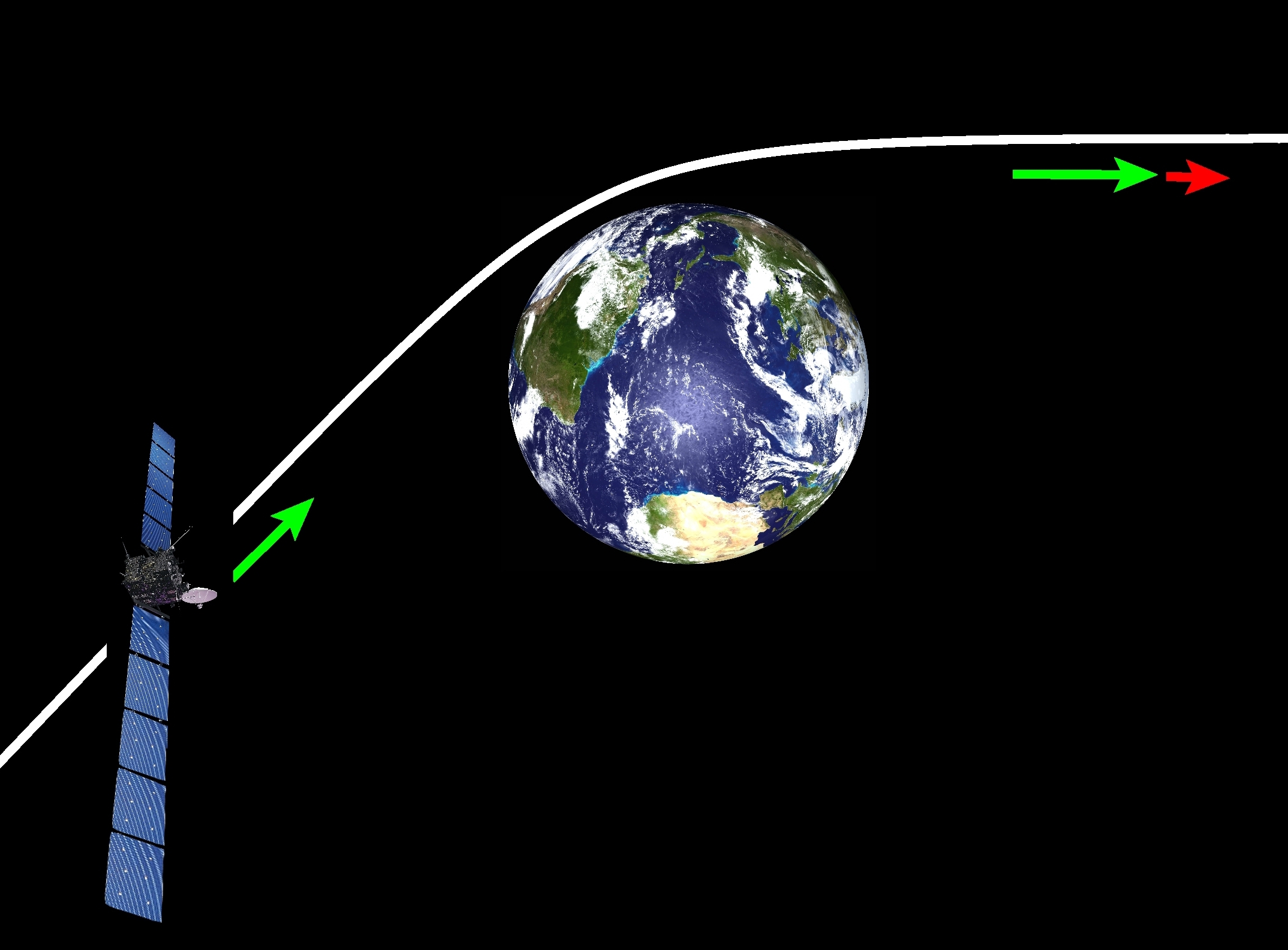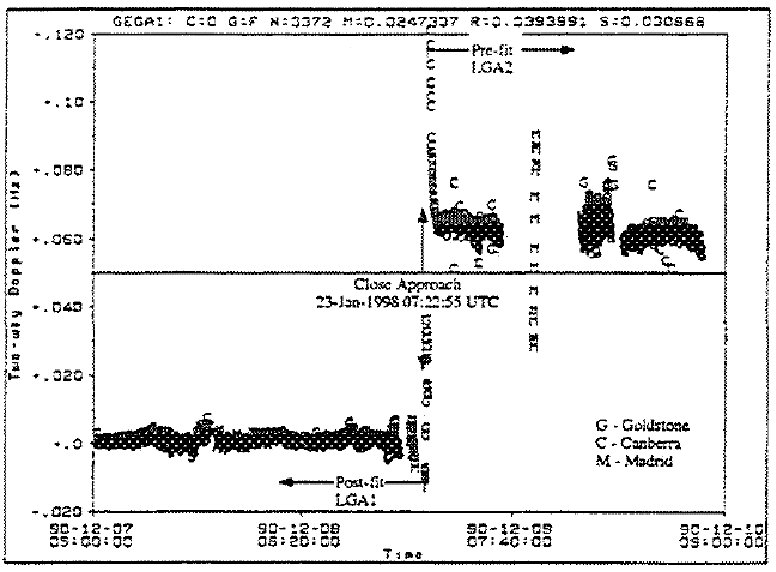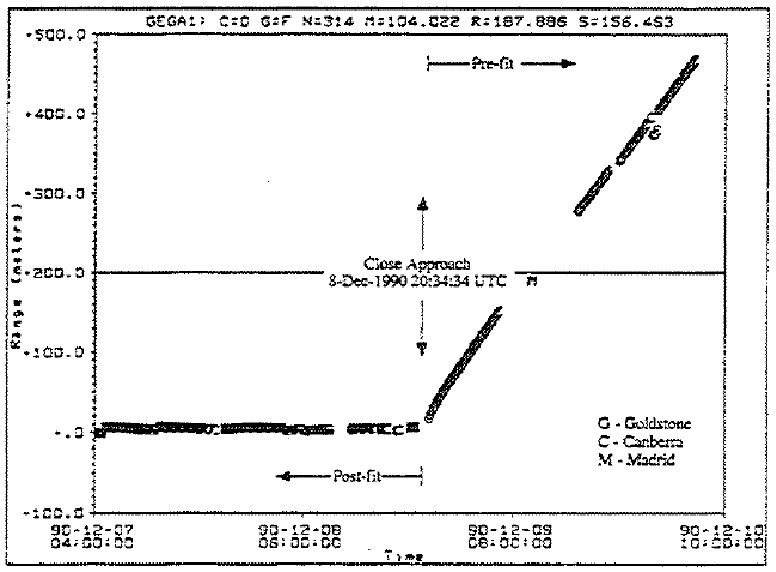
Second Team Meeting at ISSI, Bern, Switzerland: March 1-4, 2010
Last updated: Oct. 26, 2008 webmaster |
Scientific
Rationale The Flyby Anomaly is an unexpected and unexplained significant velocity change (by a few mm/s) of satellites during an Earth flyby [1, 2, 3, 4], see Fig. 1 and Table 1. This de/increase of the kinetic energy has clearly been shown in [5]. Various teams have investigated this phenomena, but any explanation is lacking so far. Neither thruster activities nor unusual behavior in their telemetry during their respected encounters are the origin for the anomaly. Software investigations have shown [1], that both the navigation software and the mathematical models used for deep space navigation seems to give no definitive explanation. Moreover, even first order estimates on various internal and external perturbations analyzed in [1, 3] are no promising candidates. As this anomaly has neither found any convincing interpretation or solution nor culminated into a finally convincing theory, a solution of this phenomena is of great importance for satellite navigation, orbit determination and perhaps also for fundamental physics. Several teams observe these flybys, analyze old and new data with help of Orbit Determination (Prediction) Programs, study the various perturbations and uncertainties, check the ODPs and discuss new physics. Their incentives are not only the interpretation of the anomaly and the induced achievements in fundamental physics and space science, but also the advances in the orbit determination and satellite navigation. From there, it is a matter of major interest to bring these teams together. 
 Figure 1a: Doppler-Residuals of Galileo flyby [1]. Figure 1b: Ranging data of Galileo flyby [1]. Table 1: Observed Flybys Scientific Goals In a first attempt one may relate the velocity increase to the eccentricity e of the orbit. Though we have far too less data for a thorough interpretation, a first idea is that the velocity increase really is related to the orbit: for large eccentricities (small influence of the Earth) the effect approaches zero, and for e = 1 the effect vanishes which is in agreement to the fact that his effect does not appear for bound orbits. In between there is a maximum. This not necessarily implies the effect to be gravitational, since similar features are also expected for atmospheric or Earth albedo influences. However, it gives a hint that indeed the effect is related to the particular orbit. The main problem in the analysis is not just the limited number of flybys for which sufficiently precise data are publicly available so that the anomaly can been seen at all. Even these available data suffer from low cadence and so far only allow an anomaly in the speed, but not in the direction of motion. Hence, it is a main task to compile all data of past and current flybys and to arrange a complete, accurate and continuous observation of future flybys (in particular the Earth flyby of Rosetta in November 2009). These data have then to be analyzed with help of ODPs to verify or falsify the flyby anomaly. The implications are both new hints for the explanation, and an examination of the ODPs. Furthermore, a more precise data-set should give hints to the particular direction of the local acceleration and also on the strength and, thus, to the position dependence of the anomalous force. These informations are extremely important for the search for a conventional explanation of this effect or for the modeling of a new force. Another goal is the investigation of all internal and external perturbations, computational errors and mismodelings. Topics are the analytical and numerical analysis of • internal influences: thermal radiation, gas leakage, errors in the signal propagation, radio beam reaction forces, . . . • external influences: solar pressure, solar wind, atmosphere, charging, Earth albedo, Yarkowski effect, Pointing-Robertson effect, magnetic field, . . . • computational errors: numerical stability of least-squares estimation, computational accuracy of hardware, . . . • mismodeling: reference systems, gravity models, ocean and solid tides, . . . References Here is a list of papers and books which are related to the effort to find the origin of the Flyby Anomlay. This list is not complete. Further suggestions to the organizers are welcome. [1] P.G. Antreasian and J.R. Guinn. In Astrodynamics Specialist Conf. and Exhibition, paper no 98–4287. American Institute of Aeronautics and Astronautics, Washington, 1998. [2] J.D. Anderson and J.G. Williams. Class. Quantum Grav., 18:2447, 2001. [3] C. Lämmerzahl, O. Preuss, and H. Dittus. In H. Dittus, C. Lämmerzahl, and S.G. Turyshev, editors, Lasers, Clocks, and Drag–Free: Exploration of Relativistic Gravity in Space, Springer–Verlag, Berlin, 2006. [4] J.D. Anderson, J.K. Campbell, J.E. Eklund, J. Ellis, and J.F. Jordan. Phys. Rev. Lett. 100, 091102 (2008). [5] J.D. Anderson, J.K. Campbell, and M.M. Nieto. arXiv:astro-ph/0608087. |